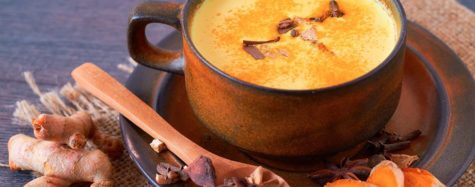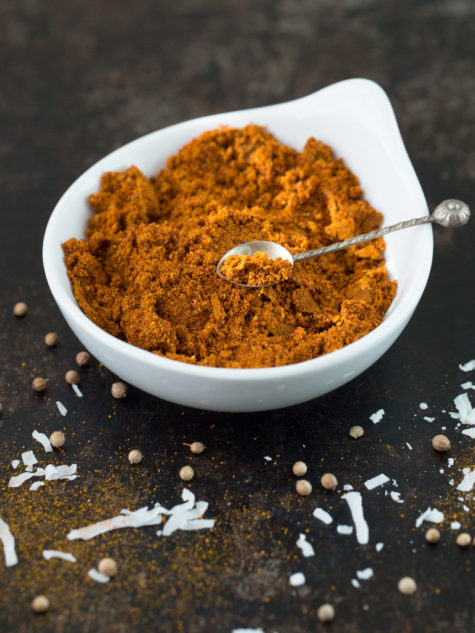AyurVeda
Moon Milk
In Ayurveda (one of the oldest systems of natural healing in the world), warm milk is a common remedy for sleeplessness. This recipe features nutmeg (a natural sleep aid) and ashwagandha (an adaptogen that helps your body deal with stress) to shepherd you to dreamland. Look for ashwagandha at health food stores, Indian specialty stores, or Whole Foods.
Ingredients:
- 1 cup whole milk or unsweetened nut milk (such as hemp, almond, or cashew)
- ½ teaspoon ground cinnamon
- ½ teaspoon ground turmeric
- ¼ teaspoon ground ashwagandha (or another adaptogen, like shatavari or astralagus)
- 2 pinches of ground cardamom
- Pinch of ground ginger (optional)
- Pinch of ground nutmeg
- Freshly ground black pepper
- 1 teaspoon virgin coconut oil or ghee
- 1 teaspoon honey, preferably raw
Recipe Preparation:
Bring milk to a simmer in a small saucepan over medium-low heat. Whisk in cinnamon, turmeric, ashwagandha, cardamom, ginger, if using, and nutmeg; season with pepper. Whisk vigorously to incorporate any clumps. Add coconut oil, reduce heat to low, and continue to cook until warmed through, 5–10 minutes (the longer you go, the stronger the medicine). Remove from heat and let cool slightly. Stir in honey (you want to avoid cooking honey or you’ll destroy its healing goodness). Pour into a mug, drink warm, and climb right into bed.
Found at: Bon Appetit
Simple Ojas Nightly Tonic
According to Ayurveda, chronic or excessive stress depletes a precious substance in the body called ojas. Ojas means vigor or vitality and is said to support healthy sleep, vitality, and virility cycles. In Ayurveda, there are certain foods and herbs that build ojas, and it all starts with milk.
To replenish and revitalize, and for a good night sleep, here’s a recipe for a mix of ingredients that can be made in advance and then added to a nightly cup of hot milk:
To 1 cup hot milk, add 1.5 tsp of the following mix:
- Chopped dates (1 tbsp)
- Chopped almonds (2 tsp)
- Coconut meat or flakes (1 tbsp)
- Saffron (1/2 tsp)
- Ghee (1-2 tsp)
- Cardamom (1/8 tsp)
Source: LifeSpa
Hot Milk Before Bed
A cup of hot milk before bed sets the stage for smooth transition into sleep. It soothes the nerves and, if you prepare it just right, it is tasty and full of nutrients. According to AyurVeda, milk is balancing to vata and pitta doshas.
Here’s a recipe to make your own delicious treat:
Boil the milk. Watch milk carefully until it boils, then let it continue to boil on low for about 5-10 minutes. Add spices (if desired).
- Turmeric reduces inflammation.
- Cardamom aids in digestion and adds sweetness.
- Cinnamon and ginger stimulate digestion and add a spicy kick.
- Vanilla flavor is also a delicious choice.
Pour the milk into your mug or cup of choice. Let sit until no longer scalding.
Optional:
After the milk cools completely, a teaspoon of honey or maple syrup can be added for sweetness. You can also add a half teaspoon of ghee (clarified butter).
Drink your milk and enjoy!
Note:
Milk does increase kapha dosha, which can cause weight gain, but this effect is lessened by using 2% or skim milk in place of whole milk. Hot milk pacifies vata dosha in the body and mind, allowing one to settle down for sleep.
In addition to these ayurvedic benefits, milk also supplies:
- Calcium, which keeps bones and teeth healthy and helps your body maintain bone mass
- Protein, a good source of energy that builds and repairs your muscle tissue
- Potassium, which helps maintain good blood pressure
- Phosphorus:, which strengthens your bones and gives you energy
- Vitamin D, which maintains bone density
- Vitamin B12, which maintains healthy red blood cells and nerve tissue
- Vitamin A which maintains the immune system, normal vision and good skin
- Niacin, which improves metabolism
Tonight, try boiling a cup of milk and feel the benefits for yourself. It may take a few tries to find the exact balance of spices you enjoy, but once you discover your favorites you will have a tasty new way to unwind in the evenings.
A Kitchari Fast
In Ayurveda, the ancient wisdom of India dating back 5,000 years, this mix of rice and mung beans is considered extremely easy to digest and is said to purify the digestion and cleanse the body of toxins. Ayurvedic physicians often prescribe a kitchari diet before, during, and after panchakarma, a rejuvenative treatment that cleanses toxins stored in bodily tissues as it restores systemic balance.
Kitchari provides solid nourishment while allowing the body to devote energy to healing. You can safely subsist on kitchari anytime in order to build vitality and strength as it helps balance all three doshas. For restless vata, the warm soup is grounding; for fiery pitta, its spices are calming; and for chilly kapha, it provides healing warmth.
According to Vasant Lad, in his book, The Complete Book of Ayurvedic Home Remedies, “A five-day kitchari fast, using plain kitchari with just some chopped cilantro leaves added, will cleanse the system and help to strengthen memory.”
Kitchari fasting is actually a mono-diet, which means the body receives a limited diversity of foodstuffs and therefore needs to produce a limited number of digestive enzymes. The work of the digestive system is lessened, allowing for greater healing and cleansing to occur. A kitchari cleanse can be calming, soothing and warming.
Kitchari tastes like a cross between a creamy rice cereal and a light dal, or lentil soup. If it is a cold, blustery day or you are feeling under the weather, a steaming bowl of this classic Indian comfort food can both warm up your bones and restore sagging energy. Everyone has his or her own special method of making kitchari. Ayurvedic Cooking for Self Healing offers a half-dozen kitchari recipes, including this one found on Yoga Journal:
Ingredients:
- 1 cup split yellow mung beans
- 1 tbsp peeled, chopped fresh ginger
- 2 tbsp shredded coconut
- handful chopped cilantro
- 1/2 cup water
- 1/2 tsp cinnamon
- 1/4 tsp each of cardamom, pepper, clove powder, turmeric, salt
- 3 bay leaves
- 3 tbsp ghee or butter
- 1 cup raw basmati rice
- 6 cups water
Directions:
First, rinse the mung beans and soak for several hours. Set aside. In a blender, liquefy the peeled, chopped ginger, shredded coconut, chopped cilantro with one-half cup of water. In a large saucepan, lightly brown the spices, salt; and bay leaves (remove before serving) in the ghee, or butter.
Drain the beans and then stir them into the spice mixture in the saucepan. Next, add the basmati rice. Stir in the blended spice and coconut mixture, followed by six cups of water. Bring to a boil, cover, and cook on low heat for approximately 25 to 30 minutes until soft.
Healthy Heart Spice Mix
- 1 part ground turmeric
- 2 parts ground cumin
- 3 parts ground coriander
- 4 parts ground fennel
Directions:
Mix the spices and store in an airtight jar. When it is time to cook the meal, steam the vegetables. Melt a small amount of ghee in the pan, and add ½ to 1 teaspoon of the spice mixture per serving. Sauté the spices until the flavor is released. Add the vegetables, sauté lightly, add salt and pepper to taste, and serve immediately.
Source: Mapi.com
Immunity Boosting Spice Mix
Here is an ayurvedic spice mixture for enhancing immunity.
Ingredients:
- 6 parts turmeric
- 3 parts cumin
- 3 parts coriander
- 6 parts fennel
- 1 part powdered dry ginger
- 1 part black pepper
- ¼ part ground cinnamon
Directions:
Roast whole cumin, coriander, fennel and black pepper and then grind the mixture into a powder. Or dry-fry them, mix all the powdered spices well and store in an airtight container in a cool place away from direct sunlight.
For daily use:
Sauté the spices in ghee, heating until you smell the aroma. Immediately remove the pan from the heat to avoid burning the spices. and sprinkle or drizzle on vegetables, rice or other grains, or cook them in vegetables like a soup.
Or add steamed vegetables to the spice mixture while still in the pan and stir. Or sprinkle them on your food if you eat your noon meal out. Add salt and pepper to taste.
This spice mixture should be used regularly to flavor one dish for the main meal of the day to boost immunity and enhance digestion.
Emotional Balance Spice Mix
- 1 part ground black pepper
- 1 part ground dried ginger
- 2 parts ground coriander
- 3 parts ground cumin
- 2 parts ground turmeric
- 1 part crushed black cumin (for women only)
Directions:
Mix the spices together and store in an airtight container. Sauté small amounts in ghee to spice vegetables and grains.
Note:
Spices contain a lipid-soluble portion and a water-soluble portion, so ideally some of the mixture should be sautéed in ghee or a healthy oil such as olive oil and added to dishes, and some cooked in the liquid portions of dishes, such as by being added to soups, stews or sauces during the cooking process. Ghee helps transport the therapeutic value of spices to the different parts of the body, so ayurveda generally recommends including a ghee-spice mixture in at least one meal of the day.
Spices are like herbs: they work gently and gradually, with the benefits adding up over time and no dangerous side effects.
Source: Mapi.com
Cholesterol-Balancing Spice Mix
Ingredients:
- 3 parts ground turmeric
- 6 parts ground cumin
- 6 parts ground coriander
- 6 parts ground fennel
- 2 parts ground fenugreek
- 1 part dried powdered ginger
- 1 part ground black pepper
Directions:
Combine the spices and store in a sealed container. When preparing your meal, sauté a teaspoon of spices in a small amount of ghee or olive oil. Combine with vegetables or grains to give them a satisfying flavor and enhance digestion. Add salt to taste.
A word of caution:
If you have a Pitta imbalance, start first by cooling Pitta dosha. Follow a low-oil Pitta-pacifying diet until your Pitta is in balance. Then use this spice mixture to help lower cholesterol.
Source: Mapi.com
Allergen Season Spice Mixture
Support your body during allergen season with this tasty spice mixture.
Ingredients:
- 3 parts turmeric
- 6 parts fennel
- 6 parts coriander
- 1 part black pepper
- 1 part ginger
Directions:
Blend these spices together in bulk and store in a jar. When you are preparing a meal, place a small amount of ghee in a frying pan and heat it on medium. Add the detoxifying spice mixture, measuring out one teaspoon of spice mixture per serving of vegetables. Sauté the spices until the aroma is released, but be careful not to burn them. Add salt and pepper to taste. Add steamed vegetables, mix lightly and sauté together for one minute, or you can sauté the spice mixture in ghee and drizzle on cooked vegetables and grains.
Source: Mapi
Detox Spice Mix
Ingredients:
- 1 part turmeric
- 2 parts ground cumin
- 3 parts ground coriander
- 4 parts ground fennel
Directions:
Mix these spices together in bulk and store in a jar. When you are cooking a meal, place a small amount of ghee in a frying pan and heat on medium. Add detoxifying spice mixture, measuring out one teaspoon of spice mixture per serving of vegetables. Sauté spices until the aroma is released (but be careful not to burn). Add salt and black pepper to taste. Add steamed vegetables, mix lightly and sauté together for one minute. Or you can sauté the spice mixture in ghee and drizzle on vegetables or grains.
Source: Mapi.com












